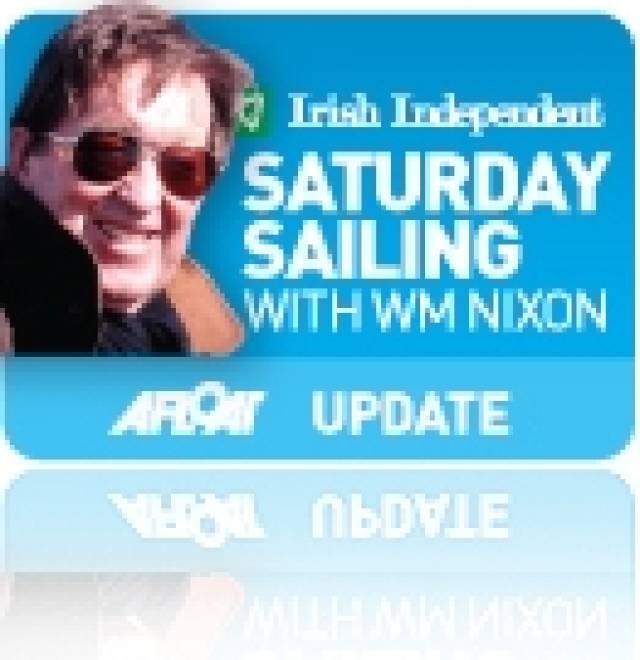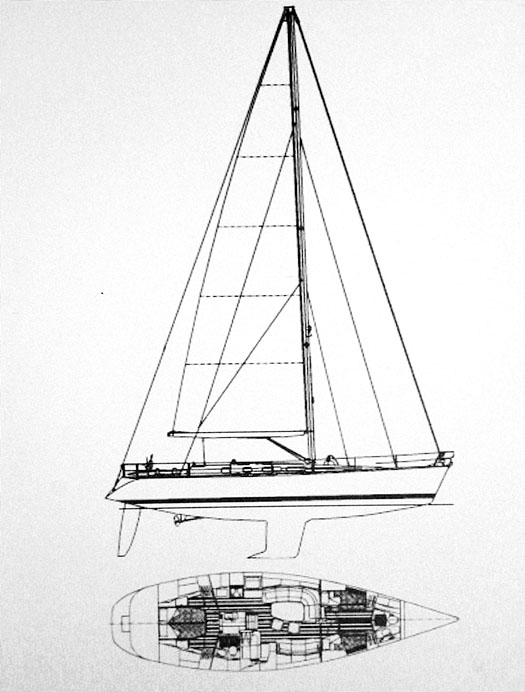#circumnavigation – A traditional global circumnavigation was celebrated in Dun Laoghaire last night with the award of the Irish Cruising Club's premier trophy, the Faulkner Cup, to Fergus Quinlan of Kinvara on Galway Bay for the log of the third stage of the 40,486 mile global circumnavigation he completed last year with his wife Kay aboard the 12M steel cutter Pylades, a van de Stadt design which he built himself between 1995 and 1997.
Those of us who have stayed on in Ireland to live through the recession should maybe have taken more notice when, around four or five year ago, architects like the skipper of Pylades started finalising plans to take off for the dream cruise, round the world in easy stages until there was a chance there might be some signs of the green shoots of recovery back home. Of all trades, it was the architectural profession which would have been the first to notice that the flamboyant growth of the tiger years was starting to wilt.
A previous decade in which long distance cruising came top of the agenda was the 1930s, when the Great Depression likewise gripped the world. Then about ten year ago when New Zealand was in localised recession, people simply spent more time sailing in what is a sailing paradise. They already had the boats to do it with, now they'd the free time. But as they didn't have the money for fancy new sails and other gear, they made do with the equipment they had. So this upsurge in sailing activity was of little benefit to the marine industry, but by living frugally afloat the people could enjoy themselves, and returned to work refreshed as the economy stared to pick up.
But in any case, when you've built a boat as good as Pylades, long distance voyaging is the only way to go. She's all of a piece, and is yet another manifestation of the versatility of Dutch designer Ricus van de Stadt (1910-1999). A couple of weeks ago, we were discussing his vision in the use of plywood construction with the Black Soo type from 1956, and Zeevalk before that in 1949. But in 1955 he was also ahead of the posse in glassfibre with the appropriately named Pionier 9, one of Europe's first production boats in GRP. Though long out of production, they're still going strong – there's one of them lying to a mooring in Malahide Estuary, just across the channel from the yacht club.
And as you'd expect from a Dutchman, he was tops with steel. The Caribbean 12 design from which Pylades was built is double chine for ease of construction, yet is still a handsome boat of the ideal size – for the life of me I can't see why anyone needs a proper cruising boat to be more than 38ft long.
With Pylades, Fegus and Kay Quinlan have made the ideal circumnavigation, quietly adhering to their own rule of staying with the boat all the way – they didn't do the usual modern thing of flying home from time to time. But they maintained an informative website, and as someone in a creative profession and a traditional musician too, Fergus is a dab hand with the words and the notions, His log is filled with much entertainment and information and the sort of thoughts that come to you on the long ocean passages – did you know, for instance, that continental separation continues at about the same speed as your fingernails grow?
It's the third year running that Pylades has been awarded the Faulkner Cup, which dates back to 1931 but hasn't been taken three times on the trot before, so history was made last night at the ICC AGM. You don't of course "win" cruising trophies, you're awarded them, which quietly deals with the notion that the essence of cruising is its non-competitive nature.
But were it not for cruising awards, we'd have few enough sources of information to trace the development of this branch of sailing, and to inspire others. Yesterday evening the adjudicator Brendan O'Callaghan had to allocate a round dozen cruising achievement trophies, while there were six other special awards by the committee, including the Wright Salver which went posthumously to Mike Balmforth for his remarkable book Cruising Ireland, published last June, while Sean Flood received the Donegan Cup for his tireless work as Ambassador for Sail Training International. Olympic sailor Annalise Murphy and her parents Con Murphy and Cathy McAleavy were awarded the John B Kearney Cup for services to sailing by this very special family whose breadth of involvement in our sport is unrivalled.
Other cruising trophies included the Strangford Cup to Jarlath Cunnane of Mayo for a 4,500 miles venture north of Russia with his much-travelled Northabout, the Atlantic Trophy went to Maire Breathnach of Dungarvan for the transoceanic crossing which completed the circuit of North America by the gaff ketch Young Larry, Paul Butler of Dun Laoghaire took the Round Ireland Cup for his informative account of a classic circuit, Brian Black of Strangford got the Rockabill Trophy for his voyage to Greenland with the 35ft Seafra, and Dickie Gomes (also of Strangford Lough) received the Fingal Cup for the Centenarian 36ft Ainmara's cruise to the Outer Hebrides and Scotland's west coast.
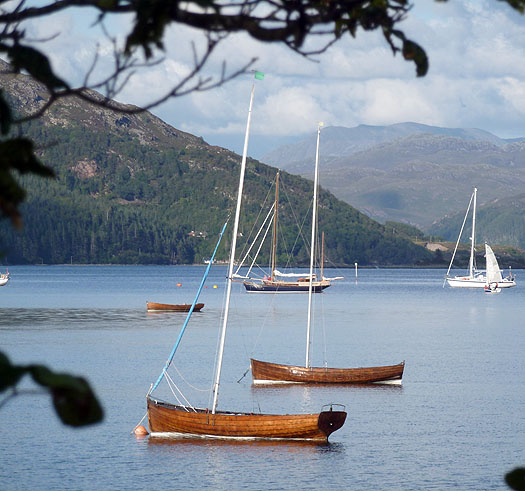
The John B Kearney-designed and built 36ft yawl Ainmara anchored off at Plockton in Wester Ross during her Centenary Cruise to Scotland which was awarded the ICC's Fingal Cup. The club's John B Kearney Cup for Services to Sailing, commemorating Ainmara's renowned designer-builder, was awarded last night to leading Dun Laoghgaire sailing family Con Murphy and Cathy MacAleavy and their daughter, Olympic sailor Annalise Murphy. Photo: W M Nixon
In other cruises, Garry Villiers-Stuart received the Wild Goose Cup for a "pilgrimage voyage" with the 1890-vintage cutter Winifeda of Greenisland, the Marie Trophy for the best cruise by a boat less than 30ft LOA goes to Mick Delap whose gaff cutter North Star is just 24ft long, the Glengarriff Trophy goes to former Fireball champions Adrian and Maeve Bell from Strangford for a cruise in Irish waters which was good despite the weather, the Perry Greer Bowl for a first log goes to Ann Lyons for a cruise among Celts fom Cork eastward, the Wybrants Cup for the best cruise in Scotland goes to Harry Whelehan of Howth whose venture to the Hebrides with the 32ft Sea Dancer found itself providing support for a currach from Kerry delivering an Irish language Bible (the first such apparently) to the religious community at Iona, and the Fortnight Cup for the best cruise in 16 days went to David Williams of Strangford Lough who managed to take the owner-built steel cutter Reiver to southern Brittany, 600 miles in the fortnight, and they got far enough south to be clear of the baleful effects of the jetstream which was blighting the weather over Ireland.

Awarded the Fortnight Cup. The 35ft steel cutter Reiver, to a design by Ian Nicolson of Alfred Mylne, was self-built by David and Peter Williams of Strangford Lough, and launched in 1988.
THE CARIBBEAN 600 SHOW GOES ON
Irish hopes in the RORC Caribbean 600, which starts on Monday from Antigua, received a horrible setback a week ago when Alan McGettigan of Dun Laoghaire's recently-acquired Swan 48 Wolfhound foundered just north of Bermuda. The boat was on a very challenging delivery passage from Connecticut via Bermuda to Antigua to take part in the race, and the crew of four with the owner in command were in no doubt about the scale of the task they faced. But with snowstorm Nemo developing over northeast America, the conditions in the Gulf Stream became extreme, and with multiple systems failures, a rescue by activating the EPIRB became necessary.
Wolfhound was a Swan 48 to this 1994 Frers design.
Nevertheless the sinking of a boat of this quality is extremely unusual, but we'll have to await the word from the crew (the ship which picked them up gets to Gibraltar next Tuesday) to learn if it was impact against the ship which sank Wolfhound. She was one of the Frers designed Swan 48s of which 57 were built between 1995 and 2003. The design was developed as the natural successor to the very successful Sparkman and Stephens-designed Swan 48 which was one of the classics which established the Nautor brand, so although Wolfhound was called a Swan 48, she was in fact just a smidgin under 51ft. This gives her even more Irish interest, as it means that at the time of her building, she was a sort of up-dated production version of Denis Doyle's legendary Moonduster, built by Crosshaven Boatyard in 1981, which was last reported to be based in Norway with an offshore sailing school in Trondheim.
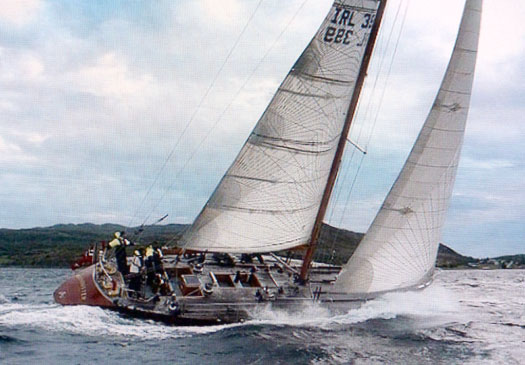
The Duster sails on. Denis Doyle's famous Frers sloop steps out seven years ago near her home port of Trondheim in Norway.
Meanwhile out in Antigua Irish hopes in the Caribbean 600 now rest with Dun Laoghaire's Michael Boyd, Niall Dowling and John Cunningham with the chartered First 40 Lancelot, the Reichel Pugh 78 Whisper skippered by Mark Dicker, and Northern Ireland's Peter Metcalfe in command of the 100ft Liara, though of course American Ron O'Hanley with the highly-fancied Cookson 50 Privateer, will find he immediately reverts to the nationality of his ancestors if Privateer does the good deed.
Defending champion Ran, the JV 72, isn't taking part this year, but her newer near sister Bella Menta (Hap Fauth, USA) is probably the bookies' favourite, though Mike Slade's ubiquitous hundred footer Leopard is on a roll after setting a new record in the Transatlantic race (she was on charter to Nik Zennstrom of Ran who fancied a bit of extra comfort to cross the pond) and can never be ruled out of contention.
NAOMH BAIRBRE AND A SILE NA GIG
The addictive Turas Huiceara on TG4 at 9.30 pm on Thursdays continued this week with Donncha and his hard-working pair of shipmates on the giant Galway Hooker Naomh Bairbre managing to get their enormous mainsail back in action with the new boom made from a tree felled in Stornoway.
Their voyage in search of Gaelic links along the Celtic seaways brought them to the Orkneys where - as suggested here last week - there's little enough trace of the Gael in a Viking-dominated archipelago. But a visit to St Magnus Cathedral, the remarkably fine mediaeval church in the Orcadian capital of Kirkwall, discovered what is apparently the most northerly Sile na Gig, a piece of unsubtle Celtic statuary incorporated into a stone archway.
There is no doubting what this little stone carving is all about - it makes even the most blatant Playboy centrefold seem totally demure by comparison. If this is the image of Irish womanhood being given to the Vikings of Orkney, no wonder they came down here in their hundreds expecting rape and pillage.
Finally heading south, the Naomh Bairbe found her way into the Caledonian Canal, with the site of the Gaelic-destroying Battle of Culloden nearby providing a mournful visit. But such are the demands of a continuous cruising narrative that there wasn't time to put Culloden into perspective, relating it to 1745 and the expedition into Scotland by that world-class messer Bonny Prince Charlie. You could understand, though, why he mightn't be mentioned – it's difficult to be serious about a man named after three sheepdogs.
Going down Loch Ness, there were interesting insights into the survival or otherwise of Gaelic in Scotland, with one speaker making the point that its disappearance means that people aren't really able to properly read the maps of their homeland, as the names of the significant features are all based on Gaelic.
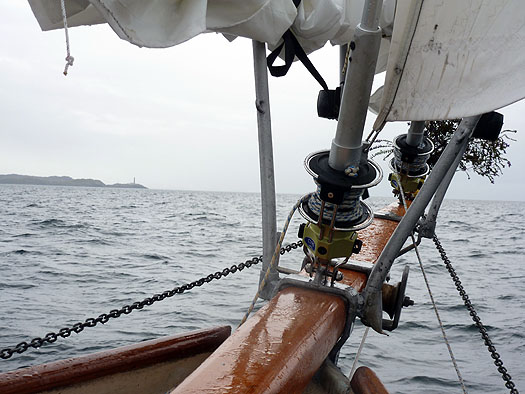
The Gaelic says it all. The Scottish mainland's exposed most westerly point is Ardnamurchan. It means the Headland of the Great Seas – this photo was taken in unusually smooth conditions, with the wind off the land, a rare experience0. Photo: W M Nixon
In fact, both the Clyde Cruising Club Sailing Directions in Scotland, and the ICC books on the Irish coast, make a point of including a large glossary of Gaelic coastal terms, as it does indeed greatly aid in "reading" a coastline. It may be a help to the survival of the old tongue, but on the other hand it simply reinforces Gaelic's featherweight status as no more than a holiday language.
Next Thursday sees the final episode of the Turas Huiceara saga. Whatever about its success as a television programme, it has been a fascinating cruise on an interesting boat, and I can only hope the crew of the Naomh Bairbe start to get some quiet enjoyment as they get nearer to home in Connemara.
Comment on this story?
We like hearing from you! Leave a message in the box below or email William Nixon on [email protected]



























